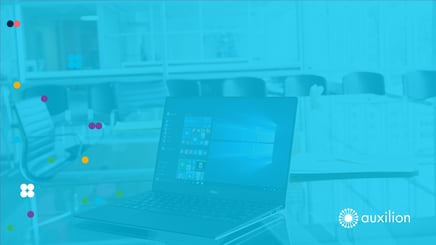Microsoft's Modern Workplace is your go-to enterprise solution, designed to empower organisations with the tools and technologies necessary to thrive in a fast-paced, interconnected world. With an array of advanced collaboration tools, cloud services, and top-notch security measures at your disposal, this suite offers a simplified approach to work that enables employees to stay connected and productive regardless of where they are.
But why should you consider embracing a modern workplace solution like Microsoft? The answer lies in its transformative capabilities for businesses. By leveraging the platform's robust features, organisations can streamline operations, enhance team communication, fortify data security measures, and ultimately boost productivity.
Throughout this guide, we will discuss each aspect of Microsoft's Modern Workplace - from its key features and benefits to navigating the transition process and selecting the right plan for your business. Our expert insights are based on first-hand experience so that you have all the information you need to make informed decisions about implementing this powerful solution.
What’s Included In Microsoft's Modern Workplace?
Microsoft's Modern Workplace encompasses a suite of tools and technologies designed to enhance productivity, collaboration, and security in today's digital work environment. Some key components included in Microsoft's Modern Workplace are:
- Microsoft 365: This integrated suite combines Office 365, Windows 10, and Enterprise Mobility + Security (EMS) to provide a comprehensive platform for productivity, communication, and security.
- Office 365: Includes familiar productivity applications such as Word, Excel, PowerPoint, Outlook, Teams, and OneNote, accessible across various devices and platforms.
- Microsoft Teams: A collaboration hub that integrates chat, video conferencing, file sharing, and application integration, facilitating teamwork and communication among employees.
- SharePoint Online: A cloud-based platform for creating, managing, and sharing documents, sites, and content within organisations, fostering collaboration and knowledge sharing.
- OneDrive for Business: A cloud storage service that enables users to securely store, sync, and share files across devices, with advanced security and compliance features.
- Windows 10: Microsoft's latest operating system offering enhanced security, productivity, and management capabilities for modern workplaces.
- Enterprise Mobility + Security (EMS): Provides identity and access management, threat protection, and mobile device management solutions to secure corporate data and devices across the organization.
- Azure Active Directory (Azure AD): A cloud-based identity and access management service that centralizes user identity and provides single sign-on to thousands of cloud applications.
Overall, Microsoft's Modern Workplace is designed to empower organisations with the tools and capabilities needed to drive productivity, collaboration, and security in today's digital age.
Key Features of Microsoft's Modern Workplace
-
Enhanced Collaboration
Microsoft's Modern Workplace stands out for its robust collaboration tools like Microsoft Teams. This platform enables seamless communication, file sharing, and real-time project collaboration among employees. By fostering teamwork and innovation within your organization, these tools not only boost efficiency but also drive success. -
Cloud Computing Excellence
Cloud services are at the core of modern workplaces, and Microsoft excels in this area with Azure. Businesses can securely store data on the cloud and access it from anywhere, at any time. This flexibility empowers remote work capabilities while ensuring data integrity and compliance with industry regulations. -
Advanced Security Measures
In an interconnected world where cybersecurity is crucial, Microsoft prioritizes security in their Modern Workplace solutions. From multi-factor authentication to threat intelligence monitoring, their comprehensive approach safeguards sensitive information against cyber threats effectively.
To illustrate how these features can transform your business operations:
- Envision teams collaborating across different locations using Microsoft Teams' chat functionality combined with file sharing.
- Imagine accessing critical documents securely from any device or location through Azure cloud services.
- Consider the peace of mind knowing that Microsoft's state-of-the-art security measures protect your company data.
By leveraging these key features offered by Microsoft's Modern Workplace solutions, businesses can streamline workflows, improve team communication regardless of physical distance or time zones while upholding top-notch security standards.
Benefits of Implementing Microsoft's Modern Workplace
-
Boosted Productivity
The modern workplace empowers employees to work smarter and collaborate seamlessly. With features like real-time co-authoring in Office applications and seamless integration with cloud services such as OneDrive and SharePoint, teams can effortlessly access and work on documents from anywhere at any time. This streamlined workflow eliminates version control issues and minimises manual tasks. -
Enhanced Communication
Effective communication is essential for success in business. Microsoft Teams serves as a centralised hub for chat-based collaboration, video conferencing, file sharing, and project management. It enables teams to stay connected regardless of their physical location or time zone, fostering improved teamwork and quicker decision-making processes. -
Fortified Security
Safeguarding data is paramount for every organisation. Microsoft's Modern Workplace offers cutting-edge security measures to effectively shield sensitive information from cyber threats. Features like multi-factor authentication (MFA), data encryption, threat intelligence monitoring, and secure remote access ensure that your business remains resilient against potential breaches. -
Cost-Efficiency
Embracing a modern workplace solution can result in substantial cost savings for businesses. By transitioning to cloud-based services like Azure Active Directory (AAD) or Office 365 subscriptions instead of maintaining on-premises infrastructure, companies can trim hardware expenses while benefiting from automatic software updates without additional licensing costs.
By embracing the power of Microsoft's Modern Workplace solution, businesses can transform their traditional work environments into dynamic interconnected spaces that empower employees to excel. It is an ideal choice for organizations seeking growth opportunities in the digital transformation era.
Understanding the Transition to Microsoft's Modern Workplace
-
Evaluate your current infrastructure
Before diving into the transition process, it is imperative to thoroughly assess your existing IT setup. Take stock of your hardware and software applications, network capabilities, and security protocols. This evaluation will help pinpoint any areas that require improvement or enhancement before integrating Microsoft's cutting-edge solutions. -
Define your objectives
Clearly outlining your goals for transitioning to a modern workplace environment is key. Are you aiming to enhance internal communication? Boost productivity levels? Strengthen data security measures? Understanding these objectives will steer your decision-making process throughout the transition phase. -
Implement change management strategies
Transitioning to a modern workplace involves significant changes in technology tools and workflows for employees. It is vital to have a robust change management plan in place encompassing training initiatives, effective communication channels, and ongoing support mechanisms. -
Choose the optimal deployment method
Microsoft offers diverse deployment options for its Modern Workplace solutions – whether cloud-based (Microsoft 365) or on-premises (Office 365). Consider factors like scalability requirements, budget constraints, and data privacy regulations when selecting the most suitable deployment method. -
Securely migrate data
Data migration plays a pivotal role in transitioning smoothly to Microsoft's Modern Workplace. Ensure all critical data undergoes secure migration without compromising its integrity or confidentiality. Collaborate closely with IT experts specialising in seamless data migration processes. -
Establish governance policies
As part of the transition journey, establish clear governance policies governing data access, sharing, and security within the organisation. Define roles and responsibilities among employees ensuring compliance with industry regulations while safeguarding sensitive information effectively. -
Provide comprehensive workforce training
Offer thorough training programs designed to acquaint employees with new tools and technologies they'll be utilizing within the modern workplace setting. This training should not only cover technical aspects but also emphasise best practices relating to collaboration, communication, and data security measures. -
Monitor progress & adapt accordingly
Transitioning towards a modern workplace demands continuous monitoring & assessment. Regularly evaluate how well the transition is progressing by gathering feedback from employees, identifying areas in need of improvement, and making necessary adjustments along the way. -
Cultivate an innovative culture
Embracing Microsoft's Modern Workplace transcends mere technological integration; it involves nurturing a culture that supports innovation within your organisation. Encourage creativity, collaboration, and adaptability in your workforce to fully leverage the capabilities offered by this solution. -
Seek expert guidance if needed
If you're uncertain about any aspect of the transition to Microsoft’s Modern Workspace, consider reaching out to IT consultants specialising in digital transformation strategies.
By following these guidelines and incorporating best practices into your transition strategy, you can ensure a successful transition to Microsoft’s Modern Workplace for business operations.
Choosing the Right Microsoft Modern Workplace Plan for Your Business
-
Assess your business requirements
Before delving into the available plans, take time to evaluate your organisation's specific needs. Consider factors such as workforce size, collaboration demands, security priorities, and financial constraints. This assessment will help you narrow down your choices and focus on plans that meet your objectives. -
Explore the range of plans
Microsoft offers several comprehensive solutions tailored for different types of businesses:
- Office 365 Business Essentials: This plan includes essential cloud services like email hosting, online meetings, file storage, and sharing capabilities.
- Office 365 Business Premium: Alongside features in Business Essentials, this plan provides desktop versions of Office applications such as Word, Excel, and PowerPoint.
- Microsoft 365 Business Basic: Formerly known as Office 365 F1 (Firstline Workers), this plan caters specifically to frontline workers who primarily need access to web-based tools.
- Microsoft 365 Apps for Enterprise: Previously known as ProPlus standalone subscription or Office Professional Plus licenses through Volume Licensing programs, this plan offers full-featured desktop versions of Office applications.
- Enterprise Plans (E1/E3/E5): These plans are designed for larger organisations with advanced collaboration needs and enhanced security features.
-
Review pricing structures
Each plan comes with its own pricing model based on user licensing or monthly subscriptions. Consider both immediate costs and long-term scalability when deciding which option fits your budget. -
Explore add-ons and supplementary services
Enhance your Modern Workplace experience with additional services offered by Microsoft such as advanced security features, data analytics tools, and customer relationship management (CRM) solutions. Evaluate whether these extras would benefit your business operations. -
Get expert advice if needed
If you're uncertain about which plan suits you best, don't hesitate to seek guidance from experts or consult with a Microsoft partner. They can assist you in navigating through various options available providing insights based on their expertise. -
Take advantage of trial periods
Utilise trial periods provided by Microsoft for certain plans. This allows you to test out features and functionalities before committing to a long-term subscription.
By carefully assessing your business requirements, exploring available plans, evaluating pricing structures, considering add-ons and supplementary services, seeking expert advice where necessary, and taking advantage of trial periods, you can make an informed decision when selecting the perfect Microsoft Modern Workplace plan for your organisation.
Get Started Today With Auxilion
With our comprehensive suite of digital transformation services, tailored to meet the evolving needs of today's workforce, Auxilion empowers organisations to navigate the complexities of the modern workplace with confidence. By leveraging cutting-edge technologies and strategic insights, Auxilion enables businesses to thrive in an era defined by change, setting the stage for success in the digital age. Embrace the future of work with Auxilion and unlock unparalleled possibilities for your organisation.
Related Articles
- How To Get The Most Out Of Your Microsoft Teams Meetings
- Microsoft 365 Exciting Developments
- How To Keep Your Business Secure With Microsoft Teams?
- The Best New Features In Microsoft Teams
- How To Use Microsoft Teams To Manage Your Team Effectively
- Using Microsoft Teams For Remote Working
- Microsoft 365 Adoption
- The Future Of Work: How Microsoft Is Redefining Modern Workplace







